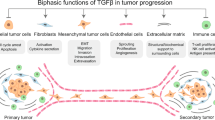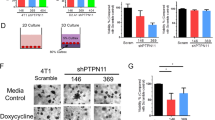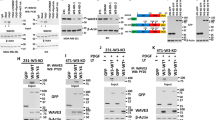Abstract
To characterize the impact of increased production of TGF-β in a xenograft model of human breast cancer, TGF-β-responsive MDA-231 cells were genetically modified by stable transfection so as to increase their production of active TGF-β1. Compared with control cells, cells that produced increased amounts of TGF-β proliferated in vitro more slowly. In vivo, however, tumors derived from these cells exhibited increased proliferation and grew at an accelerated pace. To evaluate the role of autocrine TGF-β signaling, cells were also transfected with a dominant-negative truncated type II TGF-β receptor (TβRII). Disruption of autocrine TGF-β signaling in the TGF-β-overexpressing cells reduced their in vivo growth rate. Co-inoculation of Matrigel with the TGF-β-overexpressing cells expressing the truncated TβRII compensated for their diminished in vivo growth capacity, compared with the TGF-β-overexpressing cells with an intact autocrine loop. Tissue invasion by the tumor was a distinctive feature of the TGF-β-overexpressing cells, whether or not the autocrine loop was intact. Furthermore, tumors derived from TGF-β-overexpressing cells, irrespective of the status of the autocrine TGF-β-signaling pathway, had a higher incidence of lung metastasis. Consistent with the suggestion that TGF-β's enhancement of invasion and metastasis is paracrine-based, we observed no significant differences among the cell clones in an in vitro invasion assay. Thus, in this experimental model system in vitro assays of cell proliferation and invasion do not accurately reflect in vivo observations, perhaps due to autocrine and paracrine effects of TGF-β that influence the important in vivo-based phenomena of tumor growth, invasion, and metastasis.
This is a preview of subscription content, access via your institution
Access options
Subscribe to this journal
Receive 50 print issues and online access
$259.00 per year
only $5.18 per issue
Buy this article
- Purchase on Springer Link
- Instant access to full article PDF
Prices may be subject to local taxes which are calculated during checkout





Similar content being viewed by others
References
Abe M, Harpel JG, Metz CN, Nunes I, Loskutoff D, Rifkin DB . 1994 Anal. Biochem. 216: 276–284
Anbazhagan R, Bornman DM, Johnston JC, Westra WH, Gabrielson E . 1999 Cancer Res. 59: 3363–3364
Arrick BA, Lopez AR, Elfman F, Ebner R, Damsky CH, Derynck R . 1992 J. Cell Biol. 118: 715–726
Arrick BA, Derynck R . 1996 The biological role of transforming growth factor beta in cancer development In: Molecular Endocrinology of Cancer Waxman J (ed) Cambridge University Press: New York pp 51–78
Arteaga CL, Hurd SD, Winnier AR, Johnson MD, Fendly BM, Forbes JT . 1993 J. Clin. Invest. 92: 2569–2576
Arteaga CL, Koli KM, Dugger TC, Clarke R . 1999 J. Natl. Cancer Inst. 91: 46–53
Ausubel FM, Brent R, Kingston RE, Moore DD, Siedman JG, Smith JA, Struhl K . 1987 Current protocols in molecular biology John Wiley & Sons: New York
Bandyopadhyay A, Zhu Y, Cibull ML, Bao LW, Chen CG, Sun LZ . 1999 Cancer Res. 59: 5041–5046
Bao L, Matsumura Y, Baban Y, Tarin D . 1994 Br. J. Cancer 70: 228–232
Benbow U, Schoenermark MP, Orndorff KA, Givan AL, Brinckerhoff CE . 1999 Clin. Exp. Metastasis 17: 231–238
Brand T, Schneider MD . 1995 J. Biol. Chem. 270: 8274–8284
Brunner AM, Marquardt H, Malacko AR, Lioubin MN, Purchio AF . 1989 J. Biol. Chem. 264: 13660–13664
Chang H-L, Gillett N, Figari I, Lopez AR, Palladino MA, Derynck R . 1993 Cancer Res. 53: 4391–4398
Chen TP, Carter D, Garrigue-Antar L, Reiss M . 1998 Cancer Res. 58: 4805–4810
Dalal BI, Keown PA, Greenberg AH . 1993 Am. J. Pathol. 143: 381–389
Friedman E, Gold LI, Klimstra D, Zeng Z, Winawer S, Cohen A . 1995 Cancer Epidemiol. Biomarkers Prev. 4: 549–554
Ghattas IR, Sanes JR, Majors JE . 1991 Mol. Cell. Biol. 11: 5848–5859
Gobbi H, Arteaga CL, Jensen RA, Simpson JF, Dupont WD, Olson SJ, Schuyler PA, Plummer Jr WD, Page D . 2000 Histopathology 36: 168–177
Gorsch SM, Memoli VA, Stukel TA, Gold LI, Arrick BA . 1992 Cancer Res. 52: 6949–6952
Hsu S, Huang F, Hafez M, Winawer S, Friedman E . 1994 Cell Growth Differ. 5: 267–275
Inge TH, Hoover SK, Susskind BM, Barrett SK, Bear HD . 1992 Cancer Res. 52: 1386–1392
Keeton MR, Curriden SA, Van Zonneveld A-J, Loskutoff D . 1991 J. Biol. Chem. 266: 23048–23052
Kinugasa S, Abe S, Tachibana M, Hishikawa Y, Yoshimura H, Monden N, Dhar DK, Nagasue N, Nagaoka S . 1998 Oncology 55: 582–587
Koli KM, Arteaga CL . 1996 J. Mammary Gland Biol. Neoplasia 1: 373–380
Leone A, Flatow U, King CR, Sandeen MA, Margulies IMK, Liotta LA, Steeg PS . 1991 Cell 65: 25–35
Lin HY, Wang X-F, Ng-Eaton E, Weinberg RA, Lodish HF . 1992 Cell 68: 775–785
Lu ML, Arrick BA . 2000 Oncogene 19: 6351–6360
Maehara Y, Kakeji Y, Kabashima A, Emi Y, Watanabe A, Akazawa K, Baba H, Kohnoe S, Sugimachi K . 1999 J. Clin. Oncol. 17: 607–614
Matsuzaki K, Date M, Furukawa F, Tahashi Y, Matsushita M, Sakitani K, Yamashiki N, Seki T, Saito H, Nishizawa M, Fujisawa J, Inoue K . 2000 Cancer Res. 60: 1394–1402
Matthews E, Yang T, Janulis L, Goodwin S, Kundu SD, Karpus WJ, Lee C . 2000 Br. J. Cancer 83: 519–525
McEarchern JA, Kobie JJ, Mack V, Wu RS, Meade-Tollin L, Arteaga CL, Dumont N, Besselsen D, Seftor E, Hendrix MJC, Katsanis E, Akporiaye ET . 2001 Int. J. Cancer 91: 76–82
Mullen P, Ritchie A, Langdon SP, Miller WR . 1996 Int. J. Cancer 67: 816–820
Nguyen AV, Pollard JW . 2000 Development 127: 3107–3118
Noel A, De Pauw-Gillet MC, Purnell G, Nusgens B, Lapiere CM, Foidart JM . 1993 Br. J. Cancer 68: 909–915
Oft M, Heider KH, Beug H . 1998 Curr. Biol. 8: 1243–1252
Ohmori T, Yang JL, Price JO, Arteaga CL . 1998 Exp. Cell Res. 245: 350–359
Pierce Jr DF, Gorska AE, Chytil A, Meise KS, Page DL, Coffey Jr RJ, Moses HL . 1995 Proc. Natl. Acad. Sci. USA 92: 4254–4258
Reiss M, Barcellos-Hoff MH . 1997 Breast Cancer Res. Treat. 45: 81–95
Roberts AB, Sporn MB, Assoian RK, Smith JM, Roche NS, Wakefield LM, Heine UI, Liotta LA, Falanga V, Kehrl JH, Fauci AS . 1986 Proc. Natl. Acad. Sci. USA 83: 4167–4171
Saito H, Tsujitani S, Oka S, Kondo A, Ikeguchi M, Maeta M, Kaibara N . 1999 Cancer 86: 1455–1462
Silberstein GB, Daniel CW . 1987 Science 237: 291–293
Steiner MS, Barrack ER . 1992 Mol. Endo. 6: 15–25
Sun L, Wu G, Willson JKV, Zborowska E, Yang J, Rajkarunanayake I, Wang J, Gentry LE, Wang X-F, Brattain MG . 1994 J. Biol. Chem. 269: 26449–26455
Takanami I, Imamura T, Hashizume T, Kikuchi K, Yamamoto Y, Kodaira S . 1994 J. Clin. Pathol. 47: 1098–1100
Tobin SW, Brown MK, Douville K, Payne DC, Eastman A, Arrick BA . 2001 Cell Growth Differ. 12: 109–117
Torre-Amione G, Beauchamp RD, Koeppen H, Park BH, Schreiber H, Moses HL, Rowley DA . 1990 Proc. Natl. Acad. Sci. USA 87: 1486–1490
Ueki N, Ohkawa T, Yokoyama Y, Maeda J, Kawai Y, Ikeda T, Amuro Y, Hada T, Higashino K . 1993 Japan. J. Cancer Res. 84: 589–593
Van Obberghen-Schilling E, Roche NS, Flanders KC, Sporn MB, Roberts AB . 1988 J. Biol. Chem. 263: 7741–7746
Van Slooten H-J, Bonsing BA, Hiller AJ, Colbern GT, Van Dierendonck JH, Cornelisse CJ, Smith HS . 1995 Br. J. Cancer 72: 22–30
Vukicevic S, Kleinman HK, Luyten FP, Roberts AB, Roche NS, Reddi AH . 1992 Exp. Cell Res. 202: 1–8
Wang D, Zhou G, Birkenmeier TM, Gong J, Sun L, Brattain MG . 1995 J. Biol. Chem. 270: 14154–14159
Welch DR, Fabra A, Nakajima M . 1990 Proc. Natl. Acad. Sci. USA 87: 7678–7682
Wikström P, Stattin P, Franck-Lissbrant I, Damber JE, Bergh A . 1998 Prostate 37: 19–29
Ye SC, Foster JM, Li WH, Liang JR, Zborowska E, Venkateswarlu S, Gong JG, Brattain MG, Willson JKV . 1999 Cancer Res. 59: 4725–4731
Yin JJ, Selander K, Chirgwin JM, Dallas M, Grubbs BG, Wieser R, Massagué J, Mundy GR, Guise TA . 1999 J. Clin. Invest. 103: 197–206
Acknowledgements
We thank Dr Harvey Lodish and colleagues for the TβR-II cDNA clone H2-3FF, Dr John E Majors for the pCEN/MER plasmid, and Dr Dan Rifkin for the p800LUC plasmid and the stably transfected mink lung epithelial cells. Maudine Waterman provided expert assistance with the immunohistochemical analysis. This research was supported by grants CA60928 from the National Cancer Institute and DAMD17-94-J-4130 from the Department of Defense Breast Cancer Research Program. Dr Tobin was supported by National Cancer Institute Training Grant CA09658. This publication is dedicated to the memory of Lisa Deslandes.
Author information
Authors and Affiliations
Corresponding author
Rights and permissions
About this article
Cite this article
Tobin, S., Douville, K., Benbow, U. et al. Consequences of altered TGF-β expression and responsiveness in breast cancer: evidence for autocrine and paracrine effects. Oncogene 21, 108–118 (2002). https://doi.org/10.1038/sj.onc.1205026
Received:
Revised:
Accepted:
Published:
Issue Date:
DOI: https://doi.org/10.1038/sj.onc.1205026
Keywords
This article is cited by
-
Bioinformatics analyses of combined databases identify shared differentially expressed genes in cancer and autoimmune disease
Journal of Translational Medicine (2023)
-
Transitions from mono- to co- to tri-culture uniquely affect gene expression in breast cancer, stromal, and immune compartments
Biomedical Microdevices (2016)
-
Tissue transglutaminase links TGF-β, epithelial to mesenchymal transition and a stem cell phenotype in ovarian cancer
Oncogene (2012)
-
TGF-β1 genotype and phenotype in breast cancer and their associations with IGFs and patient survival
British Journal of Cancer (2008)
-
Cited2 modulates TGF-β-mediated upregulation of MMP9
Oncogene (2006)



